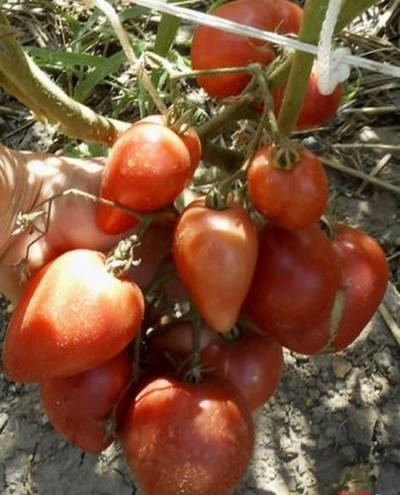
- Category: grade
- Growth type: indeterminate
- Appointment: universal
- Ripening period: mid-season
- Growing conditions: for open ground, for closed ground, for greenhouses
- Bush size: tall
- Bush height, cm: up to 180
- Bush characteristic: compact
- Ripe fruit color: brilliant crimson with golden fiery touches
- Fruit shape: heart-shaped, with a pronounced figured-elongated "nose"
The heart of the red dragon - such a romantically named tomato variety, of course, can become a faithful companion for gardeners for many years. But only if they treat him pragmatically and not romantically. And the collection of the most accurate and up-to-date information plays an important role here.
Description of the variety
It must be emphasized right away that this is a cultivar and not a hybrid plant. Culture is characterized by universality of application and indeterminacy of development. The heart of the red dragon is appropriate to use both outdoors and indoors. It will also find a worthy place in full-fledged greenhouses. High (up to 1.8 m) bushes develop compactly.
The main qualities of the fruit
Raspberry berries of the Heart of the Red Dragon shine expressively. Their coloration is complemented by golden-fiery strokes. Other main features:
weight from 200 to 400 g;
heart shape, with an elongated "nose" of the original geometry;
comparatively thin, but strong, rind.
Taste characteristics
Sweetness is typical for this variety. It is impossible to catch any sour notes in its taste. The pulp is dense and sugary. There are few seeds in it, and they have almost no effect on the perception of the berry. Due to its fineness, the rind also has little effect on the feel.
Ripening and fruiting
This variety belongs to the mid-season category. The exact information about the time frame of cultivation is not given in the official description of the plant. Third-party materials mention that the Heart of the Red Dragon bears the first berries 114-126 days after the emergence of the early growth. Further, the formation of fruits will take a long time and in large quantities.
Yield
This indicator is also not reported in the official description. Third-party sources indicate that the culture is capable of producing 5-7 kg of berries per 1 sq. m. But this parameter predictably depends on the characteristics of the soil, on the meteorological conditions and the efforts of the farmers themselves.
The timing of planting seedlings and planting in the ground
Sowing seeds in containers is usually recommended in March. But it is not too late to do so in April. An important role is played by the quality of the landing and the exact timing, taking into account the characteristics of the region and the actually developing weather. Seedlings are picked at the stage of 1-2 true leaves. Transplantation for temporary shelters is performed in mid-May, in open gardens during June; in the last 7-10 days before transshipment, it is advisable to harden the bushes.

Growing tomato seedlings is an extremely important process, because it largely depends on whether the gardener will be able to harvest at all. All aspects must be taken into account, from seedbed preparation to planting in the ground.
Landing scheme
The most justified system is 500x600 mm.She is mentioned only in third-party sources (the official description bypasses this topic in icy silence).

Growing and care
The usual approach is:
regular feeding;
hilling;
loosening;
systematic irrigation with warm water (under the root or using a drip system).
The heart of the red dragon is necessarily grown on supports. It is recommended to keep it in 2 stems. Productivity differs quite little on any soil suitable for flowering plants in general. Planting in a seedless way has almost no prospects. Before sowing in containers, seeds are recommended to be soaked in water from a day to one and a half.
The seedling soil is formed from identical amounts of compost, soil and half the amount of sand. The deepening of seeds into the soil occurs by 5-10 mm. To get seedlings, you need a temperature of 18 to 21 degrees above zero. The picking of seedlings is carried out in the phase of 2 true leaves, and tanks 10x10 mm in size are used for this purpose.
It is better to immediately feed the dived plants. Mineral fertilizers are considered optimal feeding. By the time of transfer to open ground, the seedlings should have reached about 60 days of age. You can more accurately navigate the actual maturity of plants. The plantings will have to be weeded.




A plant needs different micronutrients at each stage of growth. All fertilizers can be divided into two groups: mineral and organic. Folk remedies are often used: iodine, yeast, bird droppings, eggshells.
It is important to observe the rate and period of feeding. This also applies to folk remedies and organic fertilizers.
Disease and pest resistance
The likelihood of fruit cracking is very low. Protection against other diseases and harmful insects is carried out in the usual way for tomatoes.


Resistant to adverse weather conditions
A very high resistance of this variety to the effects of bad weather conditions is declared. At the same time, it is nevertheless necessary not to neglect protective measures in regions with difficult unstable weather.

























































































